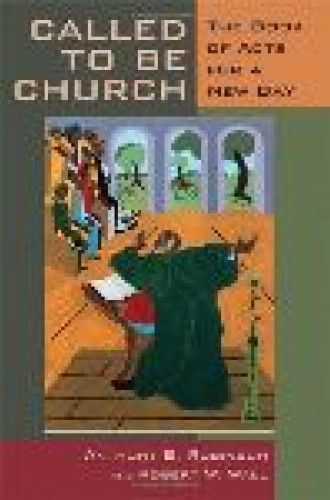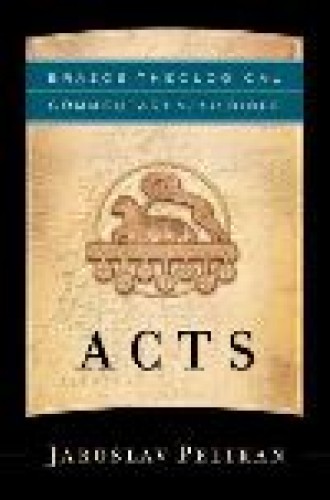Invigorating Acts
Browsing through this pair of commentaries on Acts, I found myself wondering, “What are commentaries supposed to be? And what do we need them for?” My shelves are weighted down with the usual round of Anchor Bible, Word, ICC, and Hermeneia commentaries, which translate the text, burrow behind it to explore how it came to be, discuss the historical setting and assess redactions—usually with a thin theological observation tacked on at the end for good measure. I love reading commentaries, but I have never, ever found a sermon in one.
Called to Be Church is different. It doesn’t cover every passage in Acts, but for each passage that it does cover, Robert Wall, a Bible scholar who has also produced a longer, more typical commentary on Acts, provides an essay on the text written almost in expository style, as if a Bible critic is sitting with you making comments as you read through the passage. Once Wall is done, Anthony Robinson presents another essay, approaching the text from the perspective of the kinds of questions we ask nowadays about church life. Author of the terrific book Transforming Congregational Culture (Eerdmans), Robinson is a thoughtful guide on these matters.
There is much of value here, and I would imagine that many preachers, teachers and lay readers will find the commentary to be interesting and informative. My criticisms, however, are threefold. First, this book reminds me of that much-maligned distinction Krister Stendahl made a generation ago between what the text meant and what it means. Wall explores what it meant, Robinson what it means. I don’t know whether they spoke with each other deeply in the preparation of this commentary, but as a reader I don’t detect much of a conversation going on. I would have liked to think that Wall’s dissection of the original meaning of Acts interacted with Robinson’s wrestling with contemporary church life. But I had to supply the synergy myself.
Second, though the questions Robinson addresses are important, I wonder whether his discussion of them feeds a natural tendency to bring our own questions about the church to Acts and to look for our answers there. If we are anxious about a change in pastors, look to Acts, where Matthias replaces Judas. To preach boldly, follow Peter’s example in Acts. If we harbor some ambivalence about the Holy Spirit, visit Acts, where the mark of the Spirit “is not the nonrational, emotional and ecstatic nature of the experience,” but where the Spirit has to do with “the mission of the Church, the fulfillment of God’s promises, the crossing of boundaries, and the creation of a new community.” Yes, it is inevitable that we will approach scripture this way, but reading Acts should also raise questions about the church we’d never thought of; these are the questions we need to learn to spend our time on.
Third, the text of Acts raises questions that aren’t addressed in these pages—just as they aren’t addressed in most commentaries. Called to Be Church offers much insight on Paul’s conversion, but it never asks, “Did this really happen to Paul? How did he see something from heaven? Why don’t we see Jesus in heaven in this way?” Wall does a superb job with many passages, especially the narrative in Acts 8 of Simon the magician and the Ethiopian eunuch. But when will commentaries ask from a historical perspective the questions that laypeople and pastors discover in ourselves when we read?
These authors’ good intentions are to be commended. In Wall’s introduction he points out that “neither the scholarly and popular fascination with Jesus nor the widespread exploration of spirituality has spawned or been accompanied by a similar interest in the church or the community of faith.” If we could get sharp pastors and shrewd scholars who care about the church to collaborate more intensively and publish with each other, the church would benefit greatly.
If Called to Be Church is different from most commentaries, then the volume by the late Jaroslav Pelikan, which inaugurates the Brazos Theological Commentary on the Bible, is even more different. Treating some passages at length and others sparsely, Pelikan doesn’t bother with the usual historical-critical questions (or perhaps he concluded that they are already well addressed in other commentaries). Instead he ranges widely in the zone between what the text meant and what it means: taking his cues from Irenaeus, Origen, Augustine and Chrysostom, he is focused on what the text has been understood to mean. The editors could not have found a more qualified person to probe the thick pages of the history of interpretation and Christian doctrine.
One might expect a wooden catalog of ancient comments, like “On Acts 2, Augustine said this, Jerome said that, then Bede said this other thing,” but Pelikan serves up richer fare. Drawing on a stunning array of theological writings, he looks beyond the text of Acts to themes and ultimately dogmas hovering over the text. Considering Pentecost, he plumbs the depths of the word fully (“When the day of Pentecost had fully come”) in the context of the Trinity, directing our attention toward hymns, ancient ordinals, a homily by John Paul II and Mahler’s Eighth Symphony. When the Ethiopian eunuch says “I believe,” we find ourselves reading about ancient creeds, baptismal catechisms, Leo’s tome and Luther’s German Bible. When we get to Paul’s conversion, we are treated to Cardinal Newman’s logic of conversion, Dante’s marking of time from the annunciation to Mary instead of the birth of Jesus, and Greek Orthodox liturgy. Paul visits Athens, and Pelikan probes the city’s philosophical tradition, showing how Plato, the Epicureans and the Stoics fill out the preaching moment.
This kind of commentary may leave some readers befuddled. But for many others, general editor Russ Reno’s vision for the Brazos series will be satisfied: “We must rehabilitate our exegetical imaginations.”
Scripture readers have always believed that you start with the Bible, then deduce theology or doctrine from it. But for this Brazos series (“an unashamedly dogmatic interpretation of Scripture”), doctrine “is the schematic drawing that will allow the reader to organize the vast heterogeneity of the words, images and stories of the Bible into a readable, coherent whole.”
So, what are commentaries for? We may use them to incubate sermons, but perhaps also to stretch our minds as we read the Bible, to force ourselves to read scripture more slowly, more reflectively. Just as we might gasp in awe at the sight of a cathedral and then appreciate its grandeur even more as we walk around the apse or climb into its towers, trying new angles to see as much as we can take in, perhaps we need a handful of commentaries of different types. We very much need the Anchor Bible and similar technical tomes that detail the floor plan and construction history of the place. Robinson and Wall take us on a walking tour in which we admire the pillars and see how the pews feel. And with Pelikan we can delve into the crypt or get a close-up of a high window we can’t see in detail from the floor. The question for the owners of commentaries is how much time they are able to spend in the cathedral.






